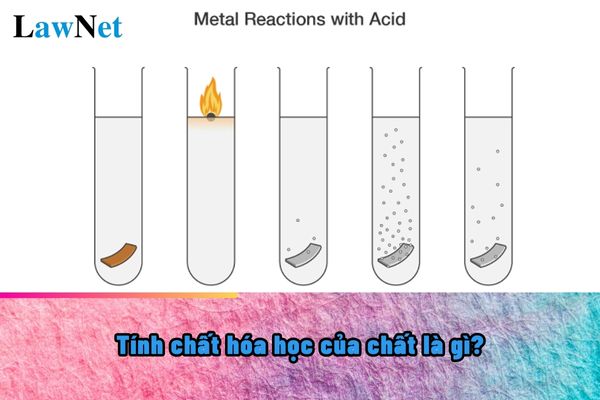What are chemical properties of a substance? What are the four perspectives for developing the Chemistry curriculum at upper secondary level in Vietnam??
What are chemical properties of a substance?
The chemical property of a substance is one of the topics that students will encounter in chemistry classes.
|
Chemical Property of a Substance - The chemical property of a substance is its ability to transform into a new substance with different components and properties. In other words, these are the characteristics of a substance manifested through the chemical reactions it takes part in. |
*Note: The information is for reference only./.

What are chemical properties of a substance? What are the four perspectives for developing the Chemistry curriculum at upper secondary level in Vietnam? (Image from the Internet)
What are the characteristics of Chemistry subject at the upper secondary level in Vietnam?
Based on Section I Annex of the General Education Curriculum for the Natural Sciences subject issued along with Circular 32/2018/TT-BGDDT, the characteristics of chemistry at the upper secondary level (grades 10-11-12) are as follows:
I. CHARACTERISTICS OF SUBJECT
Chemistry is a scientific discipline within the field of natural sciences, studying the composition, structure, properties, and transformation of elements and compounds.
Chemistry closely combines theory and experimentation, serving as a bridge to other natural science disciplines such as physics, biology, medicine, and geology. Advances in chemistry are linked with the development of new discoveries in biology, medicine, and physics. Chemistry plays an important role in life, production, and contributes to socio-economic development. Achievements in chemistry are applied in material science, energy, medical and pharmaceutical sciences, biotechnology, agriculture, forestry, fisheries, and many other fields.
In the general education program, Chemistry is a subject within the group of natural science subjects at the upper secondary school level, chosen by students based on their career orientation, interests, and capabilities. The Chemistry subject assists students in acquiring core chemistry knowledge and applying this knowledge in life, while having connections to many other educational areas.
Alongside Mathematics, Physics, Biology, Informatics, and Technology, Chemistry contributes to fostering STEM education, which is a trending educational approach being emphasized in many countries around the world.
The content of Chemistry is designed into topics that ensure reinforcement of content strands, developing the acquired knowledge and practical skills from lower grade levels, and helping students gain deeper understanding of the foundational knowledge of chemistry, forming a basis for learning, working, and research.
Each school year, students with career-oriented learning needs are required to choose three study topics suitable to their interests and the school's organizational conditions.
These topics aim to fulfill the requirement for in-depth differentiation, helping students enhance their knowledge and practical skills, applying learned knowledge and skills to solve real-world problems, meeting career-oriented requirements.
What are the four perspectives for developing the Chemistry curriculum at upper secondary level in Vietnam?
According to Section II of the Annex of the General Education Curriculum for the Natural Sciences subject issued along with Circular 32/2018/TT-BGDDT, the four perspectives for developing the Chemistry curriculum at upper secondary level in Vietnam are as follows:
The Chemistry curriculum fully adheres to the regulations stated in the comprehensive curriculum, while also deriving from the subject's characteristics, emphasizing the following perspectives:
[1] Ensuring inheritance and development
+ The Chemistry curriculum inherits and promotes the advantages of the current program, and incorporates the experience of constructing subject curricula of countries with advanced education systems globally and in the region; simultaneously, it approaches educational science and chemistry science achievements appropriate to the students' cognitive levels, psychological age, considering Vietnam's economic and social conditions.
+ The Chemistry curriculum inherits and develops the educational content of the natural science subject at the middle school level, using a concentric structure combined with a linear structure to expand and enhance knowledge and skills for students. At the middle school level, through the natural science subject, students become acquainted with some basic chemistry knowledge at a qualitative, visually descriptive level. At the upper secondary school level, Chemistry focuses on equipping students with foundational chemistry knowledge about the structure, properties, and applications of elements and compounds to explain the essence of chemical transformation processes at a necessary level.
[2] Ensuring practicality
The Chemistry curriculum emphasizes practicality, avoiding a tendency towards computation; focuses on equipping tool concepts and methods for using tools, especially helping students acquire laboratory skills, apply chemistry knowledge in understanding and solving certain practical problems to meet life’s demands.
[3] Fulfilling the career orientation requirement
The Chemistry curriculum concretizes the career-oriented educational goal. Based on identifying fields and technological processes requiring in-depth chemistry knowledge, the program selects core educational content and study topics, helping students delve deeper into chemistry knowledge with numerous practical applications, preparing for career orientation.
[4] Promoting student activity
The educational methods of the Chemistry subject contribute to promoting students' activity, proactiveness, and creativity, aiming to form chemistry capabilities and contribute to forming and developing the primary qualities and general competencies stipulated in the comprehensive curriculum.

